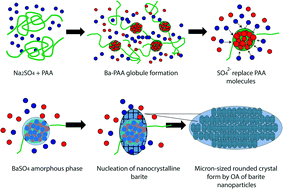Exploring the effect of poly(acrylic acid) on pre- and post-nucleation BaSO4 species: new insights into the mechanisms of crystallization control by polyelectrolytes†
Abstract
Barium sulphate (BaSO4) precipitation has been suggested to occur by non-classical pathways that include the formation of a dense liquid precursor phase, nucleation of primary nanoparticles and two levels of oriented aggregation resulting in micron-sized barite single crystals. In this study we build from this previous knowledge and explore how Ba2+ and SO42− ions associate in solution prior to nucleation of a solid phase and the effects of poly(acrylic acid) (PAA) in these pre-nucleation and post-nucleation stages. With this aim, in situ potentiometric experiments and transmission electron microscopy (TEM) observations of time-resolved quenched samples were carried out. Additional bulk precipitation experiments in which supersaturation was achieved by rapid mixing of Ba- and SO4-bearing solutions were performed. The resultant precipitates were characterized by scanning electron microscopy (FESEM and ESEM), transmission electron microscopy (TEM), X-ray diffraction (XRD) and thermogravimetric (TG) analyses. Our study provides evidence that barium sulphate precipitation occurs via the formation of ion associates in solution (ion pairs and/or clusters), that are significantly destabilized in the presence of PAA. This is associated with a noticeable delay in nucleation in the presence of PAA. Thus, our results provide indirect evidence that suggests that prenucleation ion associates must form prior to solid BaSO4 nucleation. Alternatively, BaSO4 mineralization in the presence of PAA seems to occur by a different route that consists in the formation of Ba-PAA globules in solution followed by an amorphous hydrated BaSO4 phase that transform into crystalline barite nanoparticles. PAA seems to stabilize this amorphous phase, which nevertheless also forms in the absence of PAA. Finally, single micron-sized crystals are formed by the oriented attachment of distinguishable smaller subunits, thus forming mesocrystals in the presence and absence of PAA.


 Please wait while we load your content...
Please wait while we load your content...